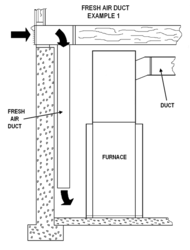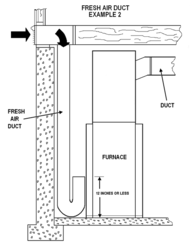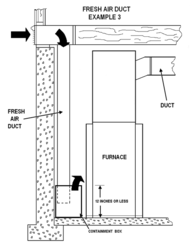Drolet Heatpro any reviews?
- Thread starter Siefert
- Start date
-
Active since 1995, Hearth.com is THE place on the internet for free information and advice about wood stoves, pellet stoves and other energy saving equipment.
We strive to provide opinions, articles, discussions and history related to Hearth Products and in a more general sense, energy issues.
We promote the EFFICIENT, RESPONSIBLE, CLEAN and SAFE use of all fuels, whether renewable or fossil.
You are using an out of date browser. It may not display this or other websites correctly.
You should upgrade or use an alternative browser.
You should upgrade or use an alternative browser.
trx250r87
Burning Hunk
I opted for the manual key damper because I had way to high of a draft. I also like the option of closing off my flue when I'm not burning, so that warm air isn't unnecessarily being removed from the house.
Another reason is that "cool" air introduced into the flue can cool it off too much.
I think there is a time and place for both options.
Eric
Another reason is that "cool" air introduced into the flue can cool it off too much.
I think there is a time and place for both options.
Eric
JRHAWK9
Minister of Fire
How do you know this? We don't know the size of the tank, or the price per gallon.
I just assumed a 500 gallon tank. So, 40% used out of 500 gallons is 200 gallons used over 20 days. He averages 10 gallons a day. Every hour his 160KBTU furnace runs it consumes ~1.75 gallons of LP, assuming his rating is accurate.
Is that bad....? If it is, I'm not far behind....lol I just briefly looked back at our records of past fillups for comparisons sake. Between 12/2004 and 1/2005 she used 352 gallons of LP in 31 days, which is 11.35 gal a day. It was before I lived here. From 2004 through 2009 she averaged ~8.2 gal a day in December and January during those 6 years. This is with a 75K BTU 92% efficiency furnace.
Last edited:
JRHAWK9
Minister of Fire
I've went through a ton of firewood also......not proud of it but to offset my propane usage and to run my propane tank to empty to replace the valves. I have been burning firewood like crazy in my prefab fireplace and puts off very very little heat.
No joke I probably use 4-5completely full loads of firewood in my copper boiler to help heat the house when I'm off work. I would estimate 250lbs of firewood a day I run it.
I know the feeling. Before I got my wood furnace I was using a pre-fab fireplace, Heat n Glo EM42. It was supposed to be a decent one in terms of heat output for fireplaces, but it ate a LOT of wood. I was putting a piece on every 10-15 minutes it seemed like. When running it during the weekend it ate A LOT. It did keep the LP furnace from turning on though as long as it was eating. I probably used about as much wood in that fireplace using it a handful of hours a day during the week after work and 10-12 hours a day on weekends as my wood furnace consumes the whole heating season. The main difference being my wood furnace now supplies 98% of my heat. With the fireplace my LP still ran a lot when I was not home or sleeping.
3fordasho
Minister of Fire
^ that is my goal
I'm thinking the keyed damper is the way to go since the pipe will be exposed on the outside of the house.
My thinking is that anything that further cools the smoke is probably a bad idea???? Make sense?
Give it a try and monitor draft with a manometer. I too have external chimneys and the Heatpro's smaller brother the Tundra runs pretty cool flue temps to begin with- extra cool air in the flue is not a good idea. Lay things out so if you have to add a barometric damper later it will be easy to do. I have two tundra installs but no barometric damper on either. I only have 15-20ft of chimney though.
Last edited:
STIHLY DAN
Minister of Fire
No it does not make sense. none what so ever. Do what the install manual says, that's what there for.^ that is my goal
I'm thinking the keyed damper is the way to go since the pipe will be exposed on the outside of the house.
My thinking is that anything that further cools the smoke is probably a bad idea???? Make sense?
laynes69
Minister of Fire
The barometric damper is used because of the automatic damper control. Now, if it had a manual damper control then I would say go for a key damper. The last option that John Gulland talks about, wrote an article on the Florida Bungalow syndrome, reduce the intakes so they match the system. These furnaces were designed for a much shorter chimney. That's why when the draft is exceeded, a damper is required.
brenndatomu
Minister of Fire
Manual says to put a baro in if draft is over -.08" WCNo it does not make sense. none what so ever. Do what the install manual says, that's what there for.
I'm almost 30. I've finally found the most amazing house on almost 6 acres(in Missouri)
My house is a story 1 1/2 with high ceilings and propane is absolutely KILLING ME!
I filled my tank(80% 770$) dec 31 as of today I'm at 40%. My house is freezing with the thermostat set around 68.
This house seems to be very well built with good insulation but I think the ceiling heights are killing me.
My furnace is a beast- York 160kbtu with 6" flue pipe that works but must be 60%-70%efficient
I am replacing the furnace with a 96% Daikin 90k btu.
I bought a Drolet Heatpro to be the answer to my prayers. I plan on running it everyday and all day long. Anyone own one? What should I be aware of? Should be pickkng up this week and installing in the next couple.
Siefert,
If you don't mind me asking where at in Missiouri? I feel your pain as I have a large 1 1/2 story with cathedral ceilings also. Before my boiler it would cost me 550 bucks a month dec-feb to heat my house with propane. I'm north of KC about 45 minutes.
I live in eureka area near six flags.
The manual says install the chimney through the roof and that's not a option
I'm obviously new and keyed damper Bari damper. I'm googling this stuff. What I am coming up with is one is manual one is automatic. If I am wrong....ok that's why I am here.
The manual says install the chimney through the roof and that's not a option
I'm obviously new and keyed damper Bari damper. I'm googling this stuff. What I am coming up with is one is manual one is automatic. If I am wrong....ok that's why I am here.
brenndatomu
Minister of Fire
You got itI'm obviously new and keyed damper Bari damper. I'm googling this stuff. What I am coming up with is one is manual one is automatic. If I am wrong....ok that's why I am here.
STIHLY DAN
Minister of Fire
No baro and manual is different. Manual restricts flue pipe while baro opens automatically regulating draft. Key damper does not regulate only restricts.
maple1
Minister of Fire
Depending on the situation, I might do both. The baro can handle the widely varying draft conditions (like a windy day or night), while the key is set to establish a 'baseline' or minumum draft. So when you're not in those windy etc. conditions, the baro is closed anyway.
I think if i was to install just one, it would be a baro.
I think if i was to install just one, it would be a baro.
maple1
Minister of Fire
There are situational things to consider too.
I'm on an open hilltop, with a 30' (or so) chimney. If I was in a sheltered area with a shorter chimney, I might not put a baro in.
I'm on an open hilltop, with a 30' (or so) chimney. If I was in a sheltered area with a shorter chimney, I might not put a baro in.
I have a baro only, and the surface behind that door is glued with tick creosote as the door is constantly open, that surface is cold and there is cold air entering... I can't set it to -0.06 without having to install 3 washers at the door weight... next opportunity that I will have to clean everything, I will add a keyed damper... I hope it didn't creosote the chimney all the way up... (first year with that setup)
I do have to figure out my draft issue though. I installed both a key and baro damper and found I don't really have excessive draft. In fact I closed up the baro damper and basically don't change the key damper.
I have noticed difficultly getting draft on a cold start. I read that opening the basement door helps and it defiantly does. Just need to figure out how to avoid having to do that
I have noticed difficultly getting draft on a cold start. I read that opening the basement door helps and it defiantly does. Just need to figure out how to avoid having to do that
I have noticed difficultly getting draft on a cold start.
Not saying that it is normal, but i'm having the same problem at this time of the year, when my basement temperature is almost as cold as outside temperature. I needed to re-adjust the key damper from half-open (middle of winter) to full open (as now), and I need to burn something really fast for the smoke not to come out from everywhere...
From the picture of my baro damper just above, I will probably try something different next winter. Instead of a fast slope just after my furnace and then a 3' of horizontal pipe to the chimney, I will go with a long slow slope all the way and install the baro directly to the pipe (no Tee)...
Last edited:
brenndatomu
Minister of Fire
I have noticed difficultly getting draft on a cold start. I read that opening the basement door helps and it defiantly does. Just need to figure out how to avoid having to do that


 Outside Air Kit (OAK) 4-6" vent from the outside. The last two pics show how to make a "cold air trap"
Outside Air Kit (OAK) 4-6" vent from the outside. The last two pics show how to make a "cold air trap"Open the HE cleanout door, blow a hair dryer on high up the center tube for a few minutes...instant draft on cold starts. Super easy/fast on Caddy/Max Caddy/Tundra/Heatpro with that cleanout door.I need to burn something really fast for the smoke not to come out from everywhere...
Last edited:
Still really enjoying this furnace. Besides the firewood being a never ending battle it has saved my family a lot of money (not including a insane amount of labor)
Any owners know the purpose or function of the rear fire bricks with the holes in them? I try and keep them clear I want just wondering when they are working (call for heat/no call for heat)
Any owners know the purpose or function of the rear fire bricks with the holes in them? I try and keep them clear I want just wondering when they are working (call for heat/no call for heat)
Similar threads
- Replies
- 7
- Views
- 437
- Replies
- 51
- Views
- 4K
- Replies
- 9
- Views
- 2K
- Replies
- 36
- Views
- 3K

